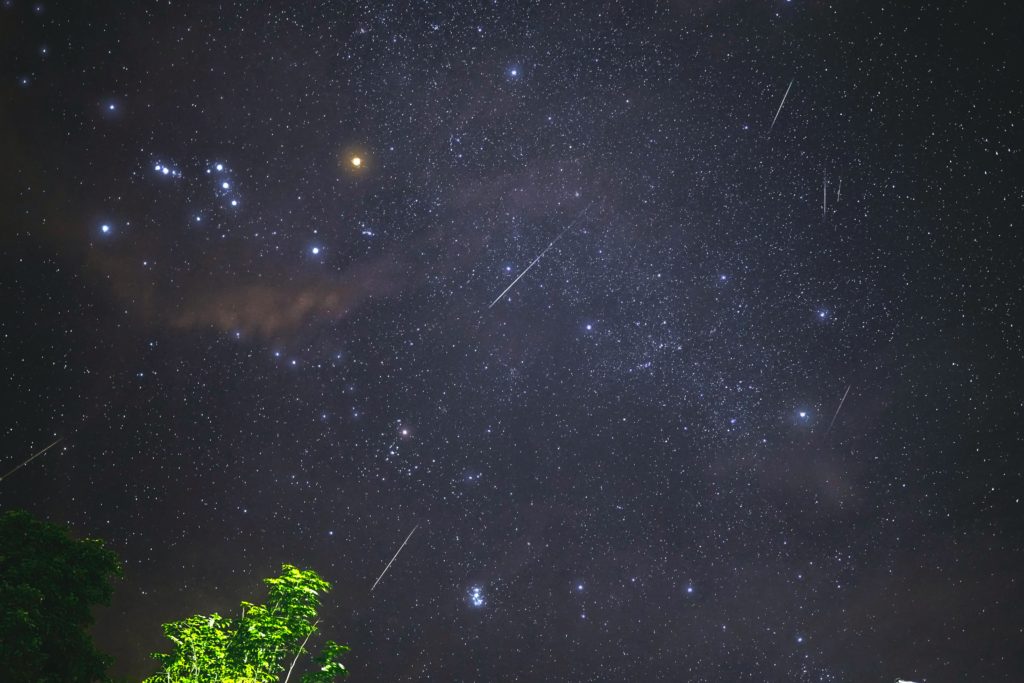Meteor showers aren’t just stunning to watch; they’re also fantastic for photography. Here’s how you can capture these celestial events in all their glory.

What Causes Meteor Showers?
Meteor showers occur when Earth passes close to a comet’s debris path. They’re named after the constellation they radiate from.
Great for Beginners
You don’t need special equipment. Meteor showers are visible to the naked eye and are perfect for aspiring astrophotographers.
When to Photograph Meteor Showers?
These showers happen all year, visible from both hemispheres. Normal night sky images or star trails can capture meteors. They vary in brightness, with the brightest called “Fireballs”.
Meteor Shower dates 2023:
There are a number of meteor showers that occur each year in the northern hemisphere. They include:
| Shower Name | Date of Maximum | Normal Limits | Possible Hourly Rate | Description |
|---|---|---|---|---|
| Quadrantids | 3-4 January | 28 Dec – 12 Jan | 110 | Bluish- or yellowish-white meteors with fine trains |
| Lyrids | 22-23 April | 14-30 April | 18 | Bright fast meteors, some with trains. Associated with Comet Thatcher |
| Eta Aquariids | 6 May | 19 Apr – 28 May | 50 | Low in the sky. Associated with Comet Halley |
| Alpha Capricornids | 30 July | 3 July – 15 Aug | 5 | Yellow slow fireballs |
| Delta Aquariids | 30 July | 12 July – 23 Aug | 25 | Steady stream of meteors over several days but a low rate per hour |
| Perseids | 12-13 August | 17 July – 24 Aug | 100 | Many bright fast meteors with trains. Associated with Comet Swift-Tuttle (1737, 1862, 1992) |
| Draconids | 8-9 October | 6-10 October | 10 | Associated with Comet 21/P Giacobini-Zimmer |
| Orionids | 21-22 October | 2 Oct – 7 Nov | 25 | Fast with fine trains. Associated with Comet Halley |
| Taurids | Southern: 10-11 Oct | Northern: 12-13 Nov | Southern: 10 Sep – 20 Nov | Northern: 20 Oct – 10 Dec |
| Leonids | 17-18 November | 6-30 November | 10 | Fast bright meteors with fine trains. Associated with Comet Tempel-Tuttle |
| Geminids | 14-15 December | 4-20 December | 150 | Plenty of bright meteors, few trains |
| Ursids | 22-23 December | 17-26 December | 10 | Sparse shower. Associated with comet 8P/Tuttle |
There are a few meteor showers best seen from the southern hemisphere. These showers include the Alpha Centaurids, Gamma Normids, Pi Puppids, Piscis Austrinids, Delta Aquarids, Alpha Capricornids, Dec Phoenicids, and the Puppid/Velids.
Photography Tips to catch meteor showers:
- Research optimal meteor shower dates.
- Go to a dark sky location, away from urban light pollution
- Start with the lowest f/ratio available (e.g. f/1.4 or f/2.8).
- Use about 20-second shutter speed.
- Begin with ISO 4000, older models ISO1600.
- Set white balance to 4000K.
- Employ a wide-angle lens.
- Turn off autofocus and focus on a bright star or infinity
- Secure focus with gaffer tape.
- Shoot in RAW format for the best post-processing options.
- Use a tripod and (wireless) remote shutter to avoid camera shake.
- Utilize a red headlamp to see controls.
- Capture a separate foreground exposure.
Astrophotography is an exciting journey and capturing meteor showers is a remarkable part of it!